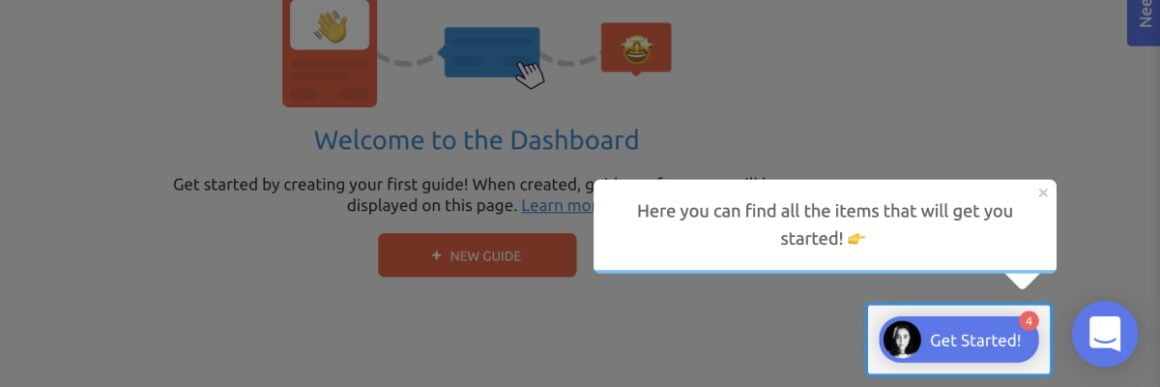

From AI-generated interactive tutorials to prioritizing leads, AI takes over traditional customer experience methods.
So, how can you leverage AI to take your product to the next level?
In this article, you’ll learn:
- how to use AI to increase your product adoption rate
- AI tools that help you create and analyze content for higher product adoption
Ready, set, go!
TL;DR
- AI enhances user experiences that improve product adoption, from hyper-personalized training to predictive insights and automated support.
- AI creates dynamic onboarding flows and identifies bottlenecks for improvement.
- Chatbots and knowledge bases handle FAQs, analyze sentiment, and prioritize support tickets.
- Enhanced data security, adaptive learning and training, and dynamic pricing models are the hottest trends to keep an eye on.
- You can use UserGuiding to create targeted in-app experiences based on AI-generated user segments and utilize its interactive elements to deliver AI-recommended content at the right time.
4 Ways to Use AI in Product Adoption
1. Enhance User Experience with AI-Powered Personalization
The key to driving product adoption lies in delivering a tailored experience. AI can help you achieve this by:
Creating hyper-personalized in-app experiences
You can utilize AI to segment users based on factors like purchase history, demographics, and in-app behavior. For example, you can categorize users as "new users," "power users," or "at-risk churners."
This will help you easily identify key pain points and understand customer needs. You can then use AI to continuously update user profiles as new data becomes available to ensure accuracy and relevance.
Similarly, AI-powered segmentation can help you create app interfaces that adapt to different user preferences, screen sizes, and device capabilities.
Or you can empower users to personalize the app's appearance with themes, colors, and fonts based on their categorization and preferences.
Another way to leverage AI is content. You can deliver content and guidance that resonates with each segment. Try offering a product tour highlighting key features for new users while providing advanced tips for power users.
Dynamically adjust content based on real-time AI insights to ensure optimal user engagement. If a user struggles with a particular feature, you can offer a targeted tooltip explaining the process.
You can also use AI to tailor explanations and examples to match the user's understanding level or offer suggestions for further exploration based on the user's progress and interests.
Tip: UserGuiding’s interactive tooltips and hotspots can be adjusted based on AI-generated insights.

Predicting user needs
Analyze user behavior to anticipate their next steps and actions. For example, frequent visits to the pricing page indicate high interest in the premium features but potential hesitation about the upgrade.
You can use AI-powered triggering to track how far a user scrolls on the pricing page.
If they reach the bottom, it might signal that they've explored all options and are ready for more information. Then, you can offer a guided tour of the premium features.
Similarly, you can use AI to offer personalized tour checklists. If, for instance, a user visits the pricing page multiple times within a specific timeframe but does not start a free trial, you can trigger a product tour with simple AI-generated instructions.
Tip: UserGuiding's onboarding checklist is great for motivating users to complete complex tasks with a progress bar.

Optimizing content delivery
Continuously refine in-app content based on user engagement data analyzed by AI.
For example, AI can point you towards particular tooltips that have a high click-through rate, so you can consider expanding them into a more detailed walkthrough.
Or you can use AI, specifically natural language processing models, to identify frequently used keywords and phrases.
It will help you detect the most effective messages, tutorials, or onboarding steps. For instance, if a specific onboarding step is frequently skipped because it takes too long, you can use AI again to generate concise summaries to improve readability and engagement.
2. Accelerate Onboarding with Intelligent Guidance
A smooth onboarding process is crucial for product adoption. AI can optimize this phase by:
Building smart onboarding flows
Create dynamic onboarding paths that adapt to user behavior and preferences using AI-driven insights.
You can use specific AI prompts to understand your product and users better when creating an onboarding flow. For example, use:
- "Describe my product in simple terms, focusing on key benefits and target audience.”
- "Create detailed user personas based on our target audience, including their goals, pain points, and motivations.”
Or you can ask AI to create specific feature prompts. Check out these examples:
- "Write an engaging onboarding copy for a feature called [feature name]."
- "Create a step-by-step tutorial for [feature name] with clear visuals."
- "Design an onboarding sequence that highlights the value of [feature name] to new users."
Remember that you need to give detailed info in your prompt to get personalized output from AI.
Identifying onboarding bottlenecks
Pinpoint areas where users struggle by analyzing user interactions with AI. If many users abandon the signup process at a specific step, investigate the reason and provide additional guidance.
Provide targeted assistance with interactive elements to help users overcome challenges. For instance, display a tooltip explaining a confusing field in a signup form.
Sometimes, it can be difficult to get the creative juices flowing to design onboarding surveys. AI can help you with the ideation phase.
First, you can ask AI to analyze your product or service, identifying key features, user roles, and potential pain points from a user’s perspective.
Based on these insights, AI can generate potential survey questions. For example, if your product is a project management tool, AI might suggest questions like:
- "How easy was it to create a new project?"
- "How helpful were the task management features?"
Tip: Once you have a list of questions, try UserGuiding to create an interactive in-app survey. UserGuiding supports feature requests, onboarding satisfaction, NPS surveys, and more!

Personalizing welcome messages
Greet users with a tailored welcome message based on their information or behavior using AI. For example, you can welcome returning users with a personalized message highlighting new features.
3. Improve Customer Support Efficiency with AI
Effective customer support can significantly impact product adoption. AI can streamline support processes by:
Automating FAQs and support requests
Implement AI-powered chatbots to handle common inquiries, freeing up your support team for more complex issues. You can create a chatbot to answer frequently asked questions about billing or technical issues.
Create in-app help centers with searchable articles to provide self-service options for users.
Tip: UserGuiding's knowledge base integration is great for users to have a more comprehensive experience.

Analyzing customer sentiment
Gauge customer satisfaction by analyzing feedback. Use AI to identify trends in customer sentiment related to specific features or product areas. For instance, you can use AI to filter and extract data related to specific features or product areas.
You can also employ AI algorithms to analyze the sentiment expressed in customer feedback. This can range from positive, negative, or neutral.
Prioritizing support tickets
Use AI to classify support tickets based on urgency and impact. For example, automatically escalate tickets related to critical issues or high-value customers.
Prioritize support efforts accordingly to ensure critical issues are addressed promptly. For instance, assign high-priority tickets to experienced support agents.
4. Drive Deeper Engagement Through AI-Driven Insights
Keeping users engaged is essential for long-term product adoption. AI can help you achieve this by:
Optimizing in-app messaging
Determine the optimal timing and content for in-app messages based on user behavior and AI insights. For example, send personalized product recommendations based on user browsing history.
Deliver highly targeted communications. You can send a limited-time offer to users who have shown interest in a particular product category.
Measuring user engagement effectively
Track key metrics and identify areas for improvement. You can measure click-through rates on different types of content to identify what resonates with users.
Analyze user behavior to uncover hidden patterns and opportunities for engagement. For instance, identify users who frequently use a particular feature and offer them exclusive content or early access to new features.
Predicting user churn
Using AI-powered predictive analytics, identify users at risk of churning. Identify users who have decreased usage or shown disinterest in recent updates.
Implement targeted retention strategies to re-engage these users and reduce churn. For instance, offer personalized discounts or exclusive content to at-risk users.
Forecasting product adoption
Predict future adoption rates based on historical data and current trends using AI. You can forecast the impact of a new feature launch on user acquisition and retention.
Anticipate challenges and opportunities to optimize product strategy and resource allocation. Identify potential bottlenecks in the user journey and allocate resources to address them proactively.
3 Hottest Trends in AI-Driven Product Adoption
Some trends in A, like machine learning, have already become a staple. Let’s see what’s new for digital transformation and product adoption:
1. Enhanced Data Security
AI-Driven Threat Detection and Response
- Anomaly Detection: AI algorithms analyze patterns in data and user behavior to detect unusual activities that may indicate a security threat, such as unauthorized access or data breaches.
- Behavioral Analytics: AI monitors user interactions and flags deviations from normal behavior, which can indicate compromised accounts or insider threats.some text
- IBM’s 2024 “Cost of a Data Breach” states that AI use in prevention workflows leads to USD 2.2 million less in breach costs compared to organizations with no AI deployment in their workflows.
2. Adaptive Learning and Training
Interactive and Context-Aware Training
- Intelligent Tutoring Systems: AI-powered systems provide real-time feedback, hints, and explanations during training sessions, adapting to learners’ responses and progress.
- Contextual Assistance: AI offers contextual help and resources based on the learner’s current task or challenge, making the training experience more relevant and practical. This is especially useful for SaaS products.
Performance Analytics and Insights
- Progress Tracking: AI monitors and analyzes learners’ progress and performance metrics, providing insights into strengths, weaknesses, and areas for improvement.
- Predictive Analytics: AI predicts future learning needs and potential challenges, enabling proactive adjustments to training strategies and content.
3. Dynamic Pricing Models
Real-Time Price Optimization
- Competitive Pricing: AI monitors competitors’ pricing strategies and adjusts prices accordingly to remain competitive and maximize market share, putting your product in front of customers with less effort.
Personalized Pricing Strategies
- Customer Segmentation: AI segments customers based on behavior, preferences, and purchase history, enabling personalized pricing models that offer tailored discounts or promotions.
- Behavioral Pricing: AI uses data on customer interactions and purchasing patterns to offer targeted pricing or special offers that encourage conversions and increase customer satisfaction.
4 AI-Driven Product Adoption Tools
1. UserGuiding

UserGuiding is a user onboarding and in-app guidance platform that helps businesses increase product adoption and reduce churn.
UserGuiding offers a range of interactive elements like tooltips, hotspots, checklists, and product tours.
While not AI-powered itself, you can integrate UserGuiding with other AI-powered tools like Intercom, Mixpanel, HubSpot, and Google Analytics to maximize personalization and data analysis.
For example, Mixpanel and Google Analytics integration will help you segment users based on behavior, demographics, and other attributes. So you can deep dive into understanding your user with UserGuiding.
You can also merge data from Intercom, Mixpanel, and HubSpot to gain a comprehensive view of your customers.
2. Pendo

Another robust digital adoption platform is Pendo, which focuses on user experience enhancement.
With features like in-app guidance, user analytics, and product feedback, Pendo provides deep insights into user behavior. Pendo’s AI features enable automated workflows and predictive analytics.
3. Zendesk

Zendesk is a comprehensive customer service platform for managing customer interactions.
Zendesk's AI-powered features include chatbots, automated ticket routing, and sentiment analysis to improve response times, increase customer satisfaction, and identify support trends.
4. Amplitude

Amplitude is a product analytics platform providing insights into user behavior and engagement.
Amplitude offers features for tracking user actions, events, and properties. Its AI capabilities include predictive analytics, user segmentation, and churn prediction to optimize product strategy and user experience.
Key Takeaways
By leveraging AI-powered platforms and tools, businesses can optimize user onboarding, deliver personalized experiences, and enhance customer support.
From predicting user behavior to automating routine tasks, AI empowers organizations to make informed decisions, increase customer satisfaction, and drive product success.

















.svg)
.svg)
.svg)
.svg)
.svg)

.svg)
.svg)












.svg)
.svg)




.png)

















